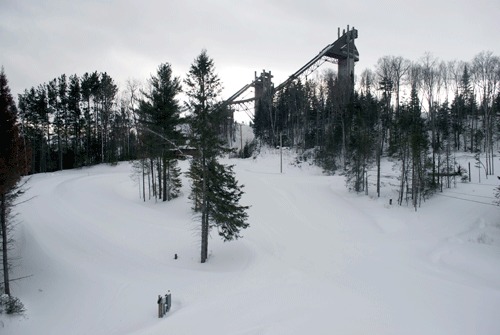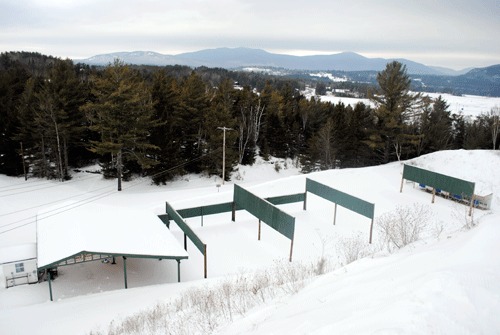Olympic biathletes’ training road starts in Lake Placid

U.S. biathletes train on this loop near the ski jumps in Lake Placid. (Enterprise photo — Matthew Turner)
KRASNAYA POLYANA, Russia – The road to the Sochi Olympics for the U.S. men’s and women’s biathlon teams began last summer on a paved roller ski loop in Lake Placid.
The coaches of both national teams say improvements to the biathlon loop at the Olympic Jumping Complex in Lake Placid have been a huge benefit to their athletes, who train there regularly in the offseason.
“They’ve helped tremendously,” said Per Nilsson, head coach of the men’s biathlon team. “I started eight years ago, and there was kind of nothing for modern biathlon training. We had no roller ski loop. They had to go to Jericho (Vermont) every Thursday. Step by step, it has developed. As a training venue, I’m really happy with what we have there now.”
The original 2-kilometer, paved roller ski loop and shooting range at the jumping complex was built in 2008. It was developed there after attempts to build a paved loop at Mount Van Hoevenburg, the site of cross-country skiing and biathlon events at the 1980 Winter Olympics, were shot down because of state land use restrictions. Mount Van Hoevenburg is located on state Forest Preserve land.
In 2012, the state Olympic Regional Development Authority, which operates Lake Placid’s former Olympic venues, expanded the roller ski loop at the jumping complex, adding another 1.5 kilometers of paved, 10-foot-wide trail. The project cost roughly $500,000 and was funded by the U.S. Olympic Committee, its sponsor 24 Hour Fitness and ORDA.

U.S. biathletes train at this firing range near the ski jumps in Lake Placid. (Enterprise photo — Matthew Turner)
“After a lot of hard work and everybody pushing together, we got that extension done with the pavement,” said Jonne Kahkonen, head coach of the U.S. women’s biathlon team. “That was a huge thing for everybody, especially the locals – Tim (Burke), Lowell (Bailey) and Annelies (Cook) – coming from that area where they had been training for a long time, always on the short loop.”
Burke is from Paul Smiths but now lives in Lake Placid. Bailey grew up in Lake Placid and lives there when he’s not traveling on the World Cup circuit. Cook, who’s from Saranac Lake, also trains in Lake Placid in the summer.
Many other biathletes representing the U.S. at the Sochi games are residents of Lake Placid during the offseason, where they live at the U.S. Olympic Training Center. That list includes, for the men, Leif Nordgren and Russell Currier, and women’s team members Susan Dunklee, Sara Studebaker and Hannah Dreissigacker, who lives in Keene while training in Lake Placid.
How much time do they spend training in Lake Placid?
“More or less they spend the whole summer there, then again from September to mid-October,” Nilsson said. “They really like to be there in the summer training because for some of them it’s home and they travel so much. We also have a camp in Bend, (Ore.) in May, and a camp in Europe in August.”
The biathlon training facility at the ski jumping complex got another upgrade last year – new snowmaking equipment. The U.S. Olympic Committee helped subsidize the project, venue manager Tony Carlino said in December.
“This year, getting the snowmaking was good for the community, not only for the biathletes,” Nilsson said. “Common people can come there and ski when we have winters (with not enough natural snow). Hopefully, it can continue to develop.”
- U.S. biathletes train at this firing range near the ski jumps in Lake Placid. (Enterprise photo — Matthew Turner)



